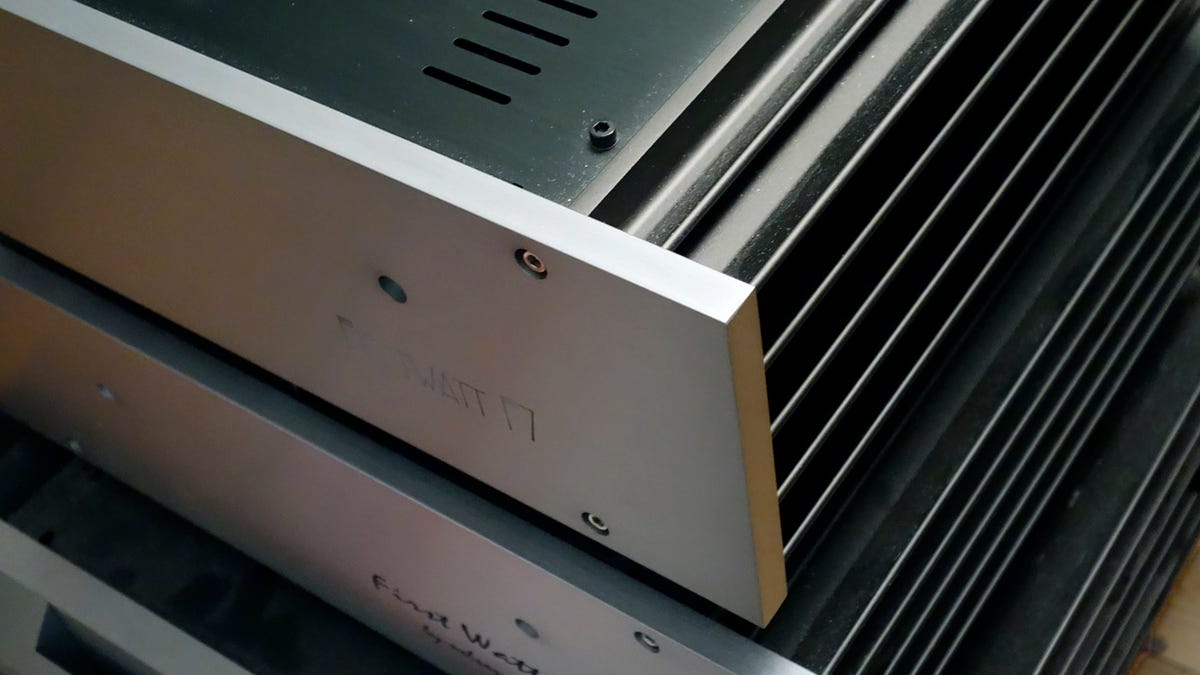This very special amplifier dazzled the Audiophiliac
In the search for excellence, the Audiophiliac spent quality time with the First Watt F7 power amplifier.

I've always loved listening to music, on the teensy transistor radios I had as a kid, and later with the audio gear I've owned over the years. I learned that with the best gear musical pleasures run deeper. When that happens you want to listen more, you're more engaged, so it's harder to stop listening and do something else.
The First Watt F7 power amplifier
All of that came into focus as I spent time with the First Watt F7 20-watt-per-channel stereo power amplifier, designed by Nelson Pass. He's a circuit design artist searching for musical truth, and he does this with keen engineering chops, matched with his ear for sound. Pass regularly performs blind listening tests to confirm he's going in the right direction as new designs take shape in his workshop. Ears are, after all, the best judges of what good sound sounds like, and he noted that some amps that measure the same don't sound the same.
This Pass quote from his website puts it this way: "The ear is not a microphone, the brain is not a tape recorder and measurements are limited in describing subjective quality. I like to have low distortion and so on, but these things take a back seat to what I experience when I listen." In other words, accuracy isn't the ultimate goal, musical satisfaction is.
The F7's rear panel has stereo RCA inputs, and a pair of all-metal speaker output connectors. The amp is a Class A design, so its side-mounted heat sinks run hot to the touch. The F7 ($3,000) is hand-crafted in California.
Nelson Pass heads two audio companies with different strategies: First Watt and Pass Labs. The First Watt lineup includes five low-powered models that are finicky about speaker matching; Pass Labs amps are more powerful and can handle any speaker on the planet.
As part of the design process Nelson Pass listened to the F7 with a set of old Tannoy HPD 15 speakers because they highlight differences in the sound of amplifiers. Pass also uses JBL, Sony, Voxativ, Zu and other speakers to evaluate the sound of his designs.
Warm and ready
The F7 is a solid-state amplifier, but one with some of the allure of tube amps. With my Magnepan .7 panel speakers the sound was not as transparent as it was with my Bowers & Wilkins 805 D3 speakers, but the 60-inch-tall panels presented a bigger, more life-size image. Still, with the .7 speakers the little amp's 20 watts per channel couldn't tap the speaker's full potential, so I tried my easier-to-drive Zu Druid V speakers, and they were an obviously better pairing. As expected the F7 required careful speaker matching, it's not going to click with every speaker, but when it does, wow! I did the bulk of my listening tests with the 805 D3 speakers.
Listening to the Rolling Stones' "12 x 5" SACD was a blast. Twenty watts indeed! I couldn't just sit there taking notes, I had to get up and jump around -- the F7 brought this 50-year-old recording roaring back to life. The Stones' earliest tunes floored me, so I played the music louder, and that only made it better.
The First Watt F7 power amplifier
Bernard Herrmann's film score "Obsession" is a grandly orchestrated symphonic piece that recalls his scores for Hitchcock films like "Psycho" and "Vertigo," and is even more darkly mysterious and unsettling. The recording was done in a studio, not a concert hall, so the engineers added a lot of artificial reverberation, and the F7 made all of that abundantly clear. Still, "Obsession" is a luscious recording, and sounds better than a lot of contemporary scores.
I also compared the F7 with my 25-watt-per-channel First Watt J2 amp that I've used in my system since 2010. For these listening tests I used my Zu Druid V speakers, and returning to the J2 the sound was exquisite, tonally rich and sweet on the "Kronos Quartet Performs Philip Glass" album. The string quartet's vigorous dynamic contrasts and textures lit up the Druid Vs with the F7, while the J2 pulled them back a bit. The J2 is more relaxed, the F7 more alive and I could hear more space and depth around the instruments. J2 and F7 are two sides of the First Watt sound, each one intriguing in its own way.
Late in the review process I brought the F7 over to a fellow audiophile's home to try with a pair of Quad 57 electrostatic speakers. The sound was vivid and palpably realistic. I'm not a fan of Quad speakers, they can sound uptight and dynamically limited, but the F7 and Quad 57s were delicious together. Putting the F7 aside, and returning to the owner's much more expensive 280-watts-per-channel ASR Emitter II amplifier, the sound was brighter and bass definition improved, but that uptight Quad sound was back. The F7 connected the musical dots better!
A lot of audiophile gear's sound appeals more to the head than the heart, but the First Watt F7 does both.

